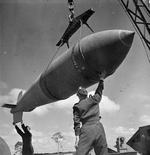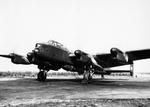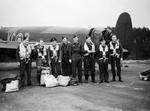RAF Woodhall Spa
| Type | 19 Air Base | |
| Historical Name of Location | Woodhall Spa, England, United Kingdom | |
| Coordinates | 53.136000000, -0.186000000 |
Contributor: Alan Chanter
ww2dbaseRAF Woodhall Spa became operational in February 1942 as a heavy bomber airfield within Ralph Cochrane's No. 5 Group. A site for the airfield, located between the town of Woodhall Spa and the village of Tattershall Thorpe in Lincolnshire, England, United Kingdom, had been identified by Air Ministry surveys early in 1941 and construction began towards the end of the year, the contractors having to clear many trees during the work. The airfield finally opened as a satellite of RAF Coningsby in February 1942. Coningsby at that time, was still without a hardened runway, and hence the Hampden bombers of No. 106 Squadron would often operate from Woodhall whenever conditions at Coningsby prevented them from taking off with a full bomb load.
ww2dbaseThe first RAF squadron to make Woodhall its permanent home was No. 97 Squadron which transferred from RAF Coningsby on 1 March 1942. As the second unit to be equipped with Lancaster bombers, this squadron was heavily involved in early operations with the new aircraft, and was famously involved in the daring low-level mission to bomb the MAN diesel engine factory at Augsburg, Germany, during which Squadron Leader John Nettleton would win the Victoria Cross. When No. 97 Squadron moved to RAF Bourn in Cambridgeshire in early 1943 they left behind three crews to form a nucleus for No. 619 Squadron which formed at Woodhall Spa in April 1943. No. 619 Squadron would be heavily involved during the year in the bombing campaigns against the Ruhr region, Hamburg, and Berlin. The latter campaign costing the squadron the loss of ten aircraft in pursuit of Arthur Harris' unrealistic promise to Winston Churchill that he could end the war by destroying Berlin "from end to end." A serious loss to the squadron occurred in August 1943 when Wing Commander I. J. McGhie, the squadron commanding officer, and his crew were one of three aircraft shot down during a raid on the German rocket research establishment at Peenemünde.
ww2dbaseIn January 1944 No. 619 Squadron moved to Coningsby and was replaced at Woodhall Spa by No. 617 "Dambusters" Squadron under the legendary Group Captain Leonard Cheshire, which brought 34 Lancaster aircraft and two Mosquito aircraft (for low-level marking) to the airfield. Cheshire, a vastly experienced pilot was one of the most outstanding commanders in Bomber Command. He eventually amassed 100 missions before being ordered to stop operational flying, and was one of the few men ever to win the Victoria Cross for a sustained period of the highest service rather than for a single act of courage. The arrival of No. 617 Squadron coincided with a reorganization of No. 5 Group into five Base Headquarters each with two satellites stations. Woodhall Spa now came under the control of No. 54 Base Headquarters at Coningsby which had Woodhall Spa and nearby Metheringham as its component satellite stations.
ww2dbaseThe target marking techniques developed by the "Dambusters" proved so successful that Sir Arthur Harris "loaned" No. 627 Squadron (a Mosquito unit in No. 8 (PFF) Group) to Cochrane's No. 5 Group to operate in the role. This was much to the annoyance of Donald Bennett, No. 8 Group's difficult and arrogant Australian commander who was less than happy at losing one of his cherished Mosquito and two Lancaster Squadrons (No. 83 and No. 97 whose role would be to illuminate the target marked by the Mosquito aircraft) over to his No. 5 Group rival whom he fiercely detested. Nevertheless, despite a direct appeal to Robert Saundby at High Wycombe the move took place and No. 627 Squadron's Mosquitos duly arrived at Woodhall Spa on 14 April 1944.
ww2dbaseIt was in a No. 627 Squadron Mosquito aircraft that Guy Gibson was killed on the night of 19/20 September 1944. At the time he was Base Operations Officer at Coningsby but decided to fly a No. 627 Squadron marker aircraft in an attack on München-Gladbach and Rheydt. He was heard giving instructions over the target but on the return flight his aircraft, which may have suffered flak damage, crashed at Steenbergen-en-Kruisland, killing both Gibson and his navigator. They are buried in the village cemetery.
ww2dbaseNo. 617 Squadron would operate from RAF Woodhall Spa until the end of hostilities, pioneering the use of Barnes Wallis' ultra-heavy bombs; the 12,000-pound "Tallboy" and 22,000-pound "Grand Slam", both of which were used against "special targets" in operations over North-West Europe. The German V-weapon launch sites were high on the list of targets for Allied aircraft and Cheshire's Squadron would play a major role in the campaign against them. On 5/6th June 1944 (D-Day), No. 617 Squadron ran "Operation Taxable" - a spoof mission by to create a "Ghost" image of an invasion fleet heading towards Le Havre, France on the German coast-watching radar. Then in August the emphasis switched to attacks on the German U-Boat pens and, on 12 November, the squadron together with Lancaster bombers from No. 9 Squadron, from nearby Bardney, successfully destroyed Adolf Hitler's feared battleship, Tirpitz, moored in a remote Norwegian fjord.
ww2dbaseIn early 1945 the Squadron made repeated daylight attacks on the German U-Boat pens. On 14th March 1945, No. 617 Squadron finally severed the Bielefeld Viaduct linking Hamm and Hanover and on 16 April. They successfully sank the German warship Lützow in Swinemünde harbour (now Swinoujscie, Poland), although with the loss of Squadron Leader Powell and his crew shot down by intense flak over the target. In total No. 617 Squadron would drop more than forty of these monsterous weapons on hitherto impregnable installations before the end of hostilities. The last operation being against the SS Headquarters at Berchtesgarden in southern Germany during which four "Tallboy" bombs were dropped.
ww2dbaseWith the end of the war in Europe, RAF Woodhall Spa was used as an assembly and kitting out point for personnel earmarked for Tiger Force, the planned heavy bomber force destined for the Far East, but after VJ Day, when Tiger Force was dispersed, No. 627 Squadron disbanded, and No. 617 Squadron moved to Waddington, the airfield was closed. In the years that followed the site was used by 92 MSU merely for the storage of bombs.
ww2dbaseFrom the late 1950s to 1965 Woodhall Spa became the base for the Bloodhound SAM missiles. With the rest of the airfield sold-off for agricultural or mineral extraction only the former missile site would survive under the control of RAF Coningsby. Overgrown and derelict by 1987 part of the former airfield consisting of the officers' mess, sergeants' mess, airmens' dining hall, NAAFI building, and ration store were acquired by the Thorpe Camp Preservation Group who have today restored the site and created a visitors centre to depict the story of RAF Woodhall Spa, its squadrons and civilian life in Lincolnshire during WWII.
ww2dbaseSources:
Thorpe Camp Visitor Centre
Sir Max Hastings, Bomber Command (Pan Books, 1981)
Patrick Otter, Lincolnshire Airfields in the Second World War (Countryside Books, 1996)
"World Aircraft Information Files", File 021/08 (Bright Star/ Aerospace Publishing)
Dr. Alfred Price, "Spoof Operations" (Aeroplane Magazine, June 2004)
Last Major Update: Dec 2013
RAF Woodhall Spa Interactive Map
Photographs
 |  |  |
RAF Woodhall Spa Timeline
| 1 Mar 1942 | No. 97 Squadron RAF was transferred to RAF Woodhall Spa, Lincolnshire, England, United Kingdom. |
| 18 Apr 1943 | No. 619 Squadron RAF was formed at RAF Woodhall Spa, Lincolnshire, England, United Kingdom. |
| 14 Apr 1944 | Mosquito aircraft of No. 627 Squadron of No. 8 (PFF) Group RAF arrived at RAF Woodhall Spa, Lincolnshire, England, United Kingdom. |
| 25 Jun 1944 | Following a visit to British No. 617 Squadron at Woodhall Spa in England, United Kingdom by USAAF Generals Carl Spaatz and James Doolittle, a crated Mustang fighter was delivered as a gift from the United States to Wing Commander Leonard Cheshire. Cheshire wanted to use it that evening for a raid on the V-bomb site at Siracourt, France, and his mechanics worked all day removing the grease and the guns. One hour after the Lancaster bombers had taken off Cheshire followed in the Mustang fighter (which type he had never flown before) and he arrived in time to mark the target at low level for the heavy bombers. |
| 15 Nov 1944 | At the White House in Washington DC, United States, President Franklin met with industrialist Henry J. Kaiser. |
Please consider supporting us on Patreon. Even $1 per month will go a long way! Thank you. Please help us spread the word: Stay updated with WW2DB: |
| WW2-Era Place Name | Woodhall Spa, England, United Kingdom |
| Lat/Long | 53.1360, -0.1860 |
- » 1,166 biographies
- » 337 events
- » 44,601 timeline entries
- » 1,243 ships
- » 350 aircraft models
- » 207 vehicle models
- » 376 weapon models
- » 123 historical documents
- » 261 facilities
- » 470 book reviews
- » 28,551 photos
- » 375 maps
General Douglas MacArthur at Leyte, 17 Oct 1944
Please consider supporting us on Patreon. Even $1 a month will go a long way. Thank you!
Or, please support us by purchasing some WW2DB merchandise at TeeSpring, Thank you!